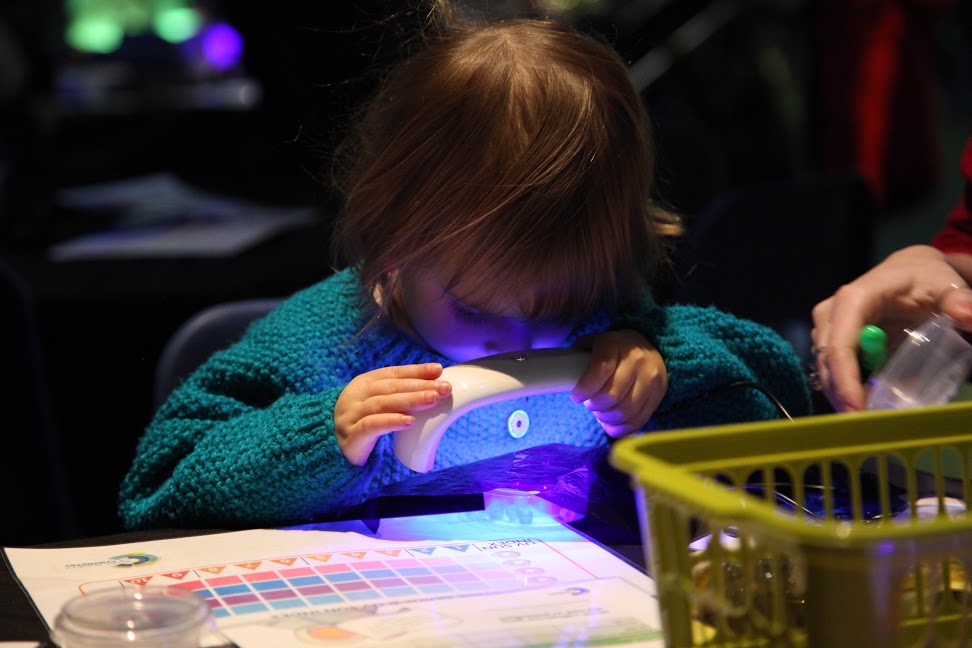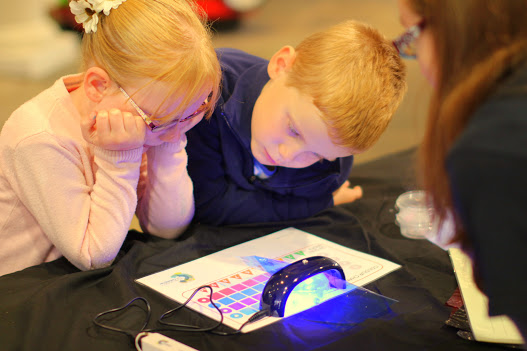Mission: Starlight Uses Space to Spark Curiosity in Chemistry
Posted on Categories Discover Magazine

How can you protect an astronaut from getting a sunburn in space?
Kids learn how chemistry can protect astronauts at England’s National Space Center in Leicester. Credit: National Space Centre, Leicester 2
The Royal Society of Chemistry in London has designed a collection of hands-on chemistry experiments that kids can do to explore this question and discover the answer for themselves.
The project is called Mission: Starlight. It is free and includes downloadable videos, worksheets, and instructions on how to teach four different hands-on, hour-long lessons and experiments designed for elementary and secondary school students.
The project was launched in 2016 during British astronaut Tim Peake’s mission aboard the International Space Station and it includes an introductory video by the popular space explorer to help ignite the students’ imaginations.
The Royal Society of Chemistry is a 175-year-old nonprofit in the U.K that brings together chemical scientists from around the world. It has 54,000 members, advises governments and partners with industry, and promotes a love for chemistry in people of all ages.
As part of its mission to produce future chemists, the organization creates free curriculum for teachers.
“Mission: Starlight is the sixth such curriculum and so far project leaders have received almost 1,000 data submissions from hundreds of schools and youth events,” said Duncan McMillian, Education and Resources Program Manager at the Royal Academy of Chemistry.
Since many participants do not submit their results, the number of participants is probably far greater, he said.

Credit: National Space Centre, Leicester 1
Students who participate use everyday materials to investigate which of them can block or limit ultra violent light.
Too much UV light can be harmful, especially to your skin, and can cause a sunburn and increase the risk of developing skin cancer, the introductory video explains.
Here on Earth, our atmosphere filters and protects us from some of this harmful light, but in space astronauts are at increased risk of UV exposure, especially on a spacewalk.
Searching for the best materials to protect astronauts is an ongoing process for space exploration agencies like NASA. With Mission: Starlight, teachers can help their students tackle a real world challenge that professional chemists face.
The basic tools needed for Mission: Starlight’s experiments include UV color changing beads, petri dishes, beakers, teaspoons, paintbrushes, stopwatches, a color chart, and sunlight.
The materials being tested for their ability to protect astronauts include cotton t-shirts, polyester sports tops, aluminum foil, milk cartons, plastic wrap, candy wrappers, vegetable oil, black tea, sunscreen, tap water, sugar, and icing.
Using such familiar materials helps participants realize the underlying nature, complexity, and utility of things that are around them every day and invites them to look beneath the surface to understand how the world works.
Students who participate in Mission: Starlight learn to observe, predict, measure, and collect data, compare results, and draw conclusions. The last experiment in the project is open-ended and can be adapted to investigate the students’ own ideas.
The students get to “publish” their data by posting it along with their photos on the Mission: Starlight website and then view and analyze it with other students’ data by using an interactive map. They can also share what they learn on Twitter by using the hash tag #globalexperiment.
Kids who share their discoveries with Mission: Starlight receive a certificate of completion and get the opportunity to “unlock” a secret video featuring the astronaut they met at the start, Tim Peake.

Children participate in Mission: Starlight experiments at the Gravity Fields Festival in Grantham, England. Credit: Copyright Heidi Dobbs
So far, students in 14 different countries, including Botswana, have participated in the project. In addition to being used in classrooms, the project’s experiments have also been demonstrated at a number of large events.
These include a space-themed Teachmeet at Burlington House in London; the National Ploughing Championships in Ireland; events in the middle of King’s Cross and Paddington Stations; at the Northern Island Science Festival; at England’s Bluedot Festival; at the Gravity Fields Festival in Grantham; and at England’s National Space Centre in Leicester.
This last event included a special appearance by Helen Sharman, a chemist and the first British astronaut and first woman to visit the Mir Space Station in 1991, who spoke to the group and tried the experiments alongside the kids.
Want more citizen science? Check out SciStarter’s Project Finder! With 1100+ citizen science projects spanning every field of research, task and age group, there’s something for everyone!